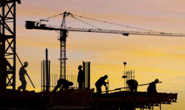Analysis

October 5, 2021
AGC: Construction Spending Flat in August
Written by David Schollaert
Total construction spending was flat for a second consecutive month in August, as a decrease in nonresidential projects offset continuing gains in residential construction, reported the Associated General Contractors of America (AGC).
Spending on infrastructure year-to-date declined when compared to the same year-ago period, leading the AGC to urge the House of Representatives to promptly approve the bipartisan infrastructure bill.
“Nearly every nonresidential spending segment has deteriorated from already inadequate 2020 levels in the first two-thirds of this year,” said Ken Simonson, AGC’s chief economist. “Meanwhile, soaring materials costs mean that fixed public budgets buy even less infrastructure than before.”
Construction spending in August totaled $1.58 trillion at a seasonally adjusted annual rate, virtually unchanged month on month. Year-to-date spending is up 7% as gains were limited to residential construction, while nonresidential construction spending slipped in August and year-to-date. The residential construction segment climbed 0.4% for the month and 26% year-to-date. Combined private and public nonresidential construction spending dropped 0.4% compared to July and 6.7% over the first eight months of 2021 compared to same 2020 period.
Most infrastructure categories posted significant year-to-date declines, said Simonson. The largest public infrastructure segment, highway and street construction, was 3.4% lower than in the same 2020 period. Spending on public transportation construction slumped 6.5% year-to-date. Investment in sewage and waste disposal structures climbed 3.8%, while funding for public water supply projects slid 1.8% and conservation and development construction plunged 18%.
Other types of nonresidential spending also decreased year-to-date. Combined private and public spending on electric power and oil and gas projects declined 3.6%. Education construction slumped 10.6%. Commercial construction – comprising warehouse, retail, and farm structures – dipped 1.7%. Office spending fell 10.1% and manufacturing construction edged down 0.8%.
Association officials said the nearly universal decline in infrastructure spending demonstrates the urgency of enacting expanded funding for a range of infrastructure project types. They called on the House to quickly pass the bipartisan bill that already passed in the Senate by a wide margin.
“This legislation includes the kind of policy priorities that members of both parties have long claimed to support,” said Stephen Sandherr, AGC’s CEO. “There is no excuse for holding these projects hostage while sorting out other priorities. Construction workers, businesses, and the public are all losing from delay in passing this legislation.”







